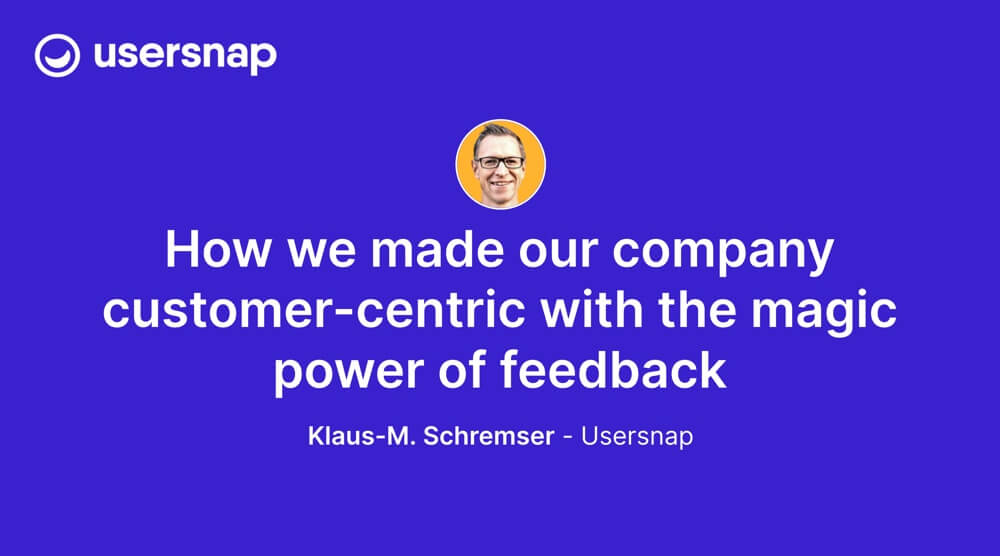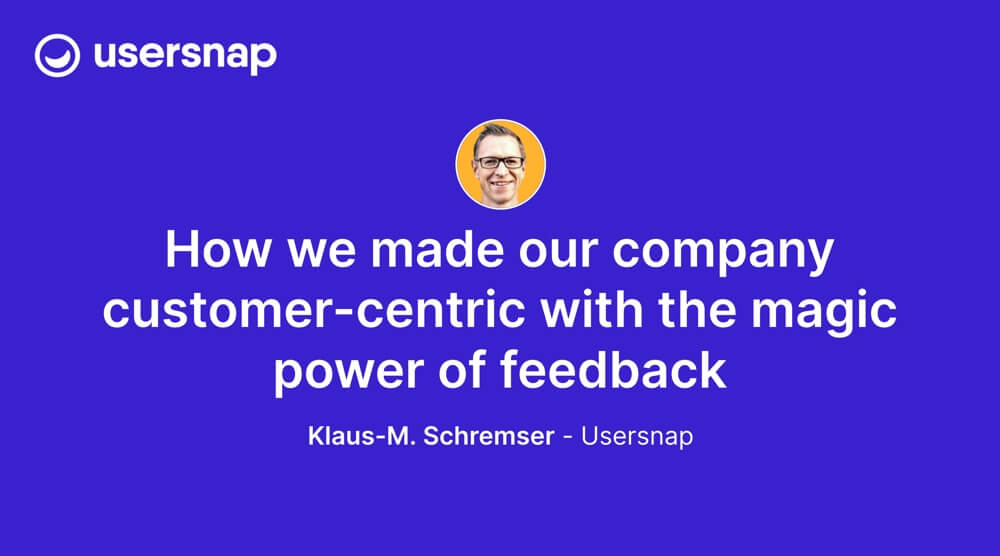
This article is an adaptation of Klaus-M. Schremser’s talk at virtual summit The Journey to Customer-Centric Growth. Replays of all 50 talks available now till June 2020.
Collecting customer feedback is the magic that turned our company into a more customer-centric organization. We agilely implemented the feedback for our product and improved the customer journey. Our monthly new customers rate doubled and product trials went up by 155%.
Klaus-M. Schremser, Head of Growth
Hello everyone, my name is Klaus-M. and in the past 20 years I was in the B2B industry, always surrounded by web technology. I love what you can do online and how technology shapes our world. I was always into marketing, sales, and had a narrow relationship with the customers.
Today, I’m a passionate head of growth at Usersnap. Usersnap is a SaaS-company providing a versatile user feedback platform to gather feedback along the digital product life cycle.
If you prefer not to read the post, maybe, you want to watch the talk (33 min) about how we became customer-centric with the magic power of feedback.
Talk about how Usersnap became customer-centric with the magic power of feedback
Problem
I want to talk about how we found our way to customer-centricity and how our product became a feedback platform.

We started out many years ago with a solution for quality assurance and user-acceptance testing. What we were good at was visual bug tracking because we built it based on a problem we had in our own projects. Understanding the issues in projects from clients and users can be really hard.
Regularly, we received emails saying “This button is not working as expected”. And we were like: “What is this button? And what did you expect?” We had 100 of “this button” on our site and it was hard to understand what the user meant or expected. So a lengthy back and forth between us and the user started to play out.
Our solution to this problem was a simple screenshot functionality, that allowed users to take an annotated screenshot and show what they were talking about. This shortened the back and forth dramatically and made it easy to understand what the users meant.
A lot of companies started using our solution, amongst them companies like Microsoft and Facebook. But after some years the growth flat-lined.
We started thinking about new ideas and areas where we could get customers on board. And of course, we looked at fast-paced startups, like Intercom. Intercom was pretty new at that time.
Let’s build a new product
When we saw what Intercom was doing, a new idea popped up in our heads. “Why not build a customer service chat solution with a visual feedback component?” That screenshot feature will make us rich and famous.
And yes, we talked to potential customers… but only when we wanted to sell them our solution. From what I can remember our questions were leading, persuasive and our listening was biased. We dug into our product data and saw that some customers connected our solution with a customer service tool.
At the end of a very short research phase, we were sure that this must be the 1 billion dollar solution back then.
We came up with a cute name: Alpaca. Everyone in the company liked the Alpaca. We still have t-shirts with Alpacas on them :).
But we couldn’t onboard customers after we spent a year on development. A whole year!
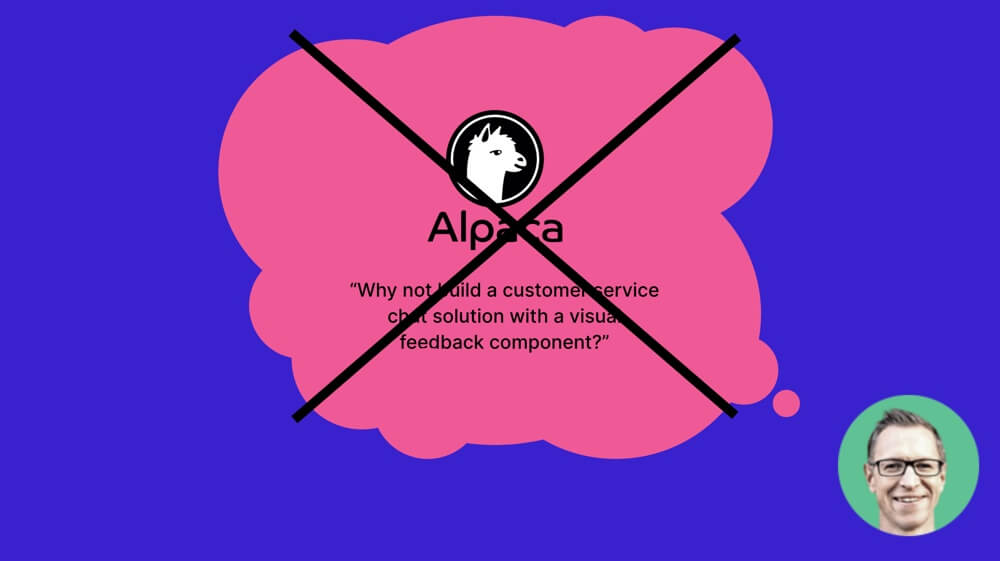
It seemed as if it never satisfied their needs and brought them no value.
Every time, someone was interested, they asked questions of how to use it which went into a different direction than we initially thought of it. We failed to deliver and we had to swallow the hard pill and stop the product. There we were, back to our original visual feedback product. We wasted one year of development.
But do not worry. I will not leave you without a happy ending.
Solution
There we were flat-lining with our initial product and limited traction.
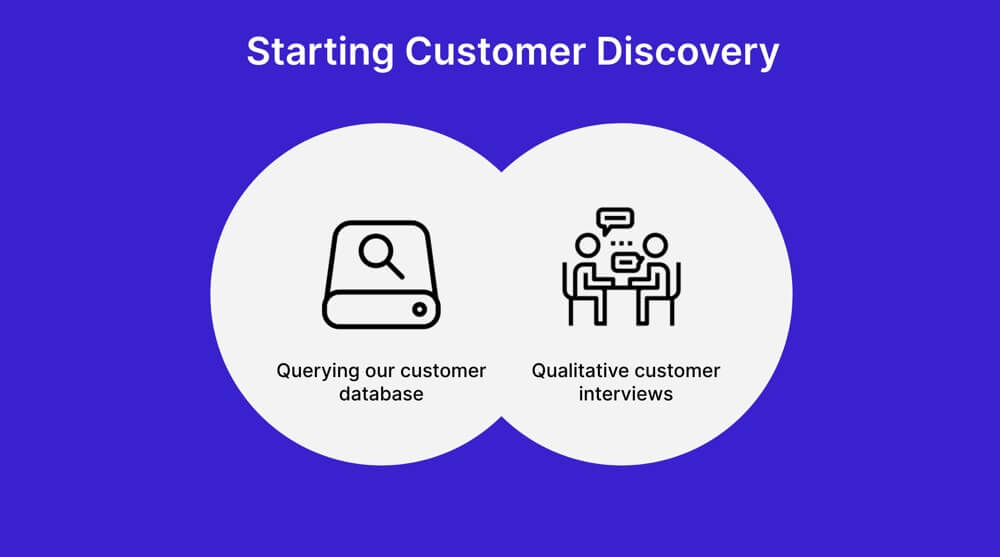
We started to dig into our existing customers and initiated qualitative customer interviews to understand their existing workflows and pains. We queried our customer database, sent out a bunch of emails, and asked for help on telling us more about their current usage, their pains, and needs.
To make this process as easy as possible, we used
Calendly to auto-schedule the calls throughout various time zonesZoom for a personal chat with a picture of each participantWe used an interview guideConfluence to write down the key findings (facts)
Don’t think that interviewing is just asking a few questions. Luckily, one of our team members was experienced in doing interviews and that saved us from wasting time on asking leading questions. This time we wanted to do it right and learn first more about what the customers thought.
For the qualitative interviews, we followed the guide from Harvard. This guide was helpful in educating me and the team to run successful qualitative interviews.
When I created my first questionnaires I had to rework them several times because I often had a solution in mind. And my questions were already going in a certain direction. We recorded the interview and wrote little summaries of each interview with the key findings. We analyzed the interviews and improved our interview skills with each interview we did and became better every time until it was easy to do.
The summaries we did right after the interview made it easier to digest all the interviews we did and others could quickly understand what we learned from the interviews.
We completed 32 qualitative interviews in a time span of 2 months and the key findings of the interviews regarding what they are using Usersnap for were:
Collecting bugs during development and QACollect customer feedback on a new projectGet feedback from SAAS customers
These findings were surprisingly coherent to what we learned from the responses of our feedback widget on the website and in the product. From a total of 52 responses that did not address a specific issue (bug, question, other complaints) during a time frame of one month we got:
67% said they were using Usersnap for customer feedback26% mention bug reporting as a reason for using Usersnap
At this point in time we thought that our solution was mainly for “Visual bug tracking”.
The learning that customers were using our solution to collect feedback from customers was interesting and worth more attention.
We got this from what our customers were telling us in our feedback widget. This was clearly a turning point at how we looked at our existing product and the potential of expanding into the field of user feedback beyond visual bug tracking.
What have we learned?
We learned about what kind of segments we are solving problems at that time. We identified four distinct segments:
AgenciesSoftware companies (SaaS in particular)EnterprisesE-commerce

From this analysis and especially from analyzing the feedback of churning customers, we learned that the software segment stayed for longer with us. They used our product on an ongoing basis and not only for a limited time to collect bugs during a project and before going online with that project.
Then, we decided to dive deeper into this segment where the customers were stickier with our product.
Several customers amongst them known ones like Hawaiian airlines and Canva collected customer feedback via Usersnap. We knew we were onto something. We wanted to understand what potential customers with the feedback solution were looking for.
Before we made our next steps, we looked at the current product development life cycle. Software companies are providing digital products. We wanted to understand better how our customers used the user feedback to influence their product development lifecycle.
Based on recent studies, 93% of companies proclaimed to have an agile product development process. The agile development process is essentially based on the lean startup method (https://www.lambdazen.com/process).
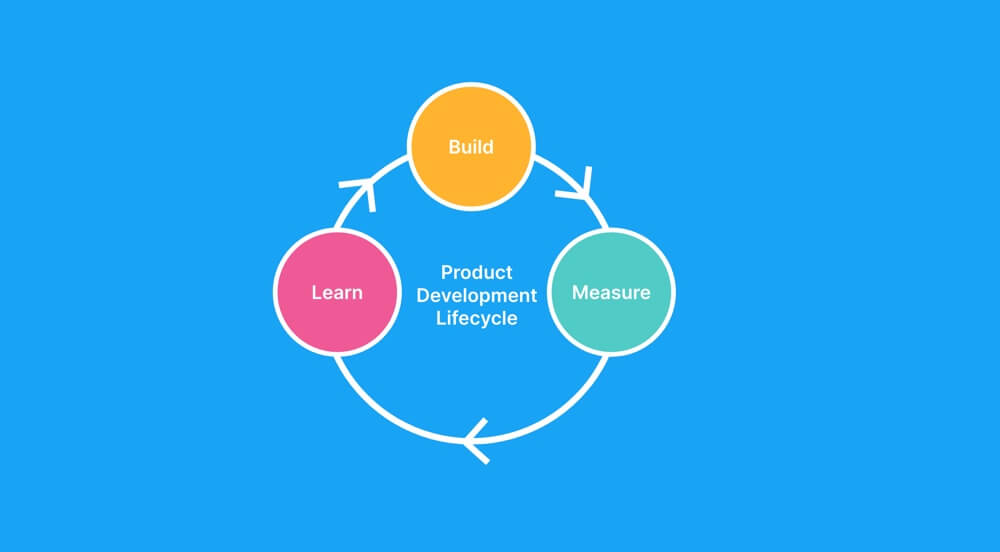
Build – measure – learn → What is interesting about this lifecycle in our opinion is that there is a lack of the voice of the user. User interviews gave us so many insights, so how should we integrate that in our day to day decisions. Also our customers were telling us that they were using the feedback they obtained to decide on what to build next.
We decided to extend the product development life cycle to:
ListenLearnBuildMeasure
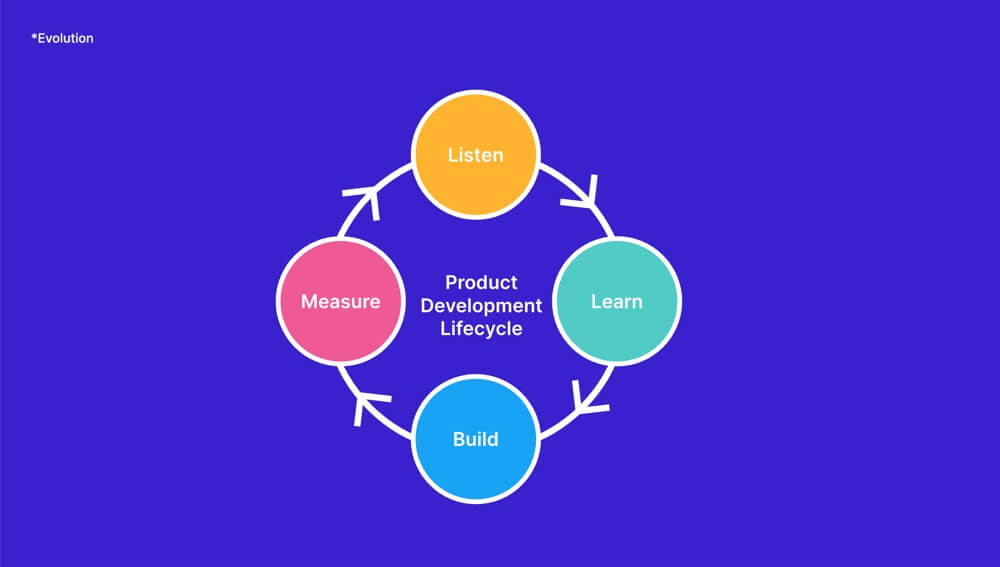
This is how we wanted to explicitly introduce the needs and pains of our users into our development lifecycle and only build features that bring value to the user and solve a pain point for our customers.
At this point, it was clear to us that we have to find out more about our customers. We crafted emails and reached out to the existing customer base and tried to learn how they are using Usersnap. The existing customers couldn’t really tell us why they were buying back then and the way they are using the product after some time is different from how new customers use the product or why they bought it in the first place. So we decided to expand our research into potential customers and those who try out our product for the first time.
From our customer research, we understood that the key personas were product managers, customer service people, product owners, and founders. Those were the ones who started searching for a customer feedback solution. We wanted to learn more about these personas and their reasons to look for a solution.
What did we do in detail?
So, how did we start our customer feedback journey? In the next step, we wanted to include customer feedback loops in every step of the customer journey.
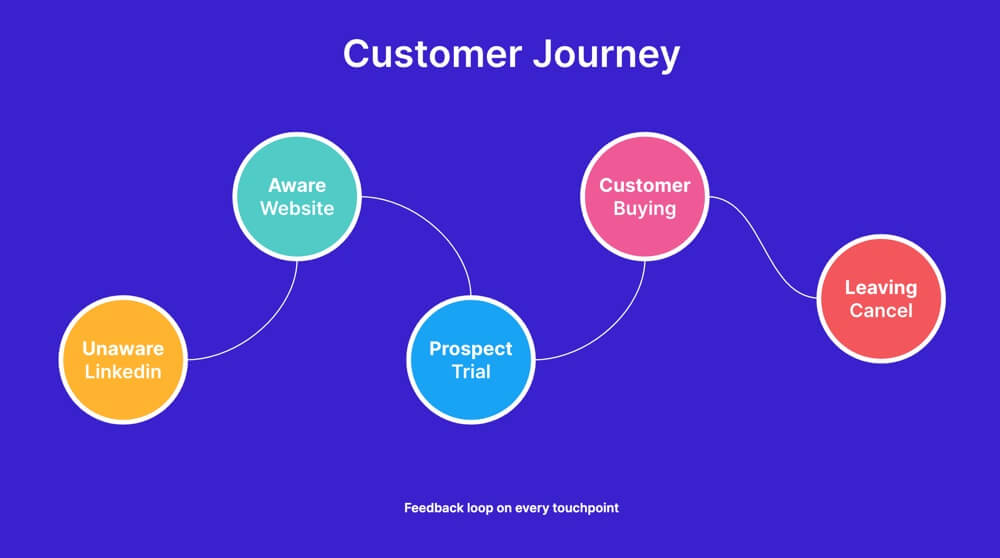
Addressing users from your target segment before they know us
We were reaching out to our key personas which we identified in the first step via social media platforms, specifically Linkedin, because on these platforms it’s easier to target a specific audience.
Our team started a customer discovery process and searched people who matched our initial hypothesis of what our perfect customer could be. We connected with a lot of people through personal messages.
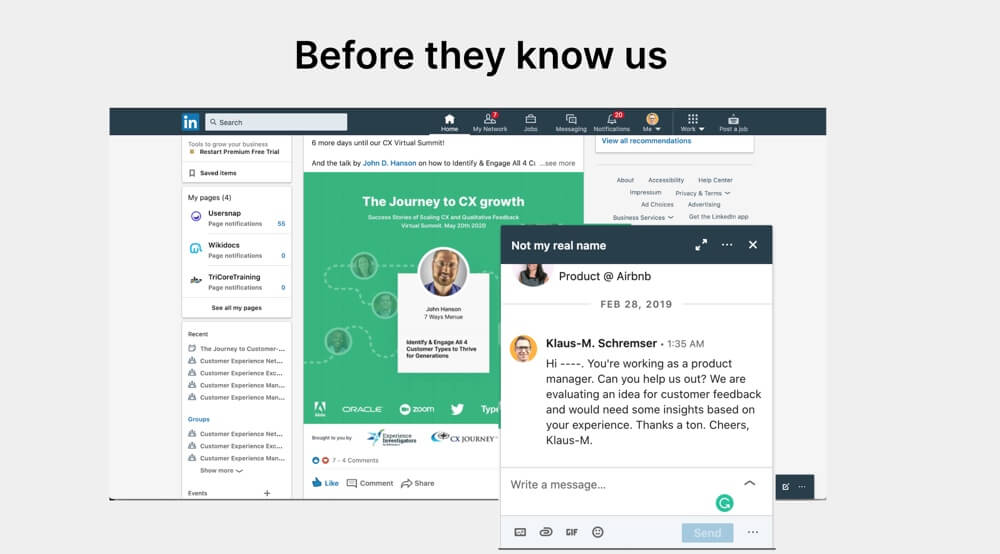
With some help from tools (like Linked Helper) we could even reach a broader audience with more or less personal messages to reach statistical significance. We asked for customer interviews asking them what jobs they have to be done in their role as product managers, customer service managers, customer experience managers, and what their current challenges are.
We got a variety of learnings from here. Specifically, we learned that product managers want to collect customer feedback and to have a tool to better analyze and categorize customer feedback to have a more efficient feature prioritization.
With this knowledge, we enhanced our existing persona pages with validated information.
What we learned:
Honest asks for help are very successful and a little gratuity like an Amazon voucher keeps your interviewees happy for follow-up sessions. We learned about the jobs-to-be-done and challenges of our target personas
Addressing potential customers on our website
As a next step we wanted to actively invite the interested visitors to give us feedback on our website. These were people who were looking for a solution and found us. Were they finding what they were looking for and what were their challenges?
We implemented non-invasive popup-messages on our website with a person from our team on it to make it very personal. Asking visitors for interviews was very successful and helped us to get 5 interviews per week.
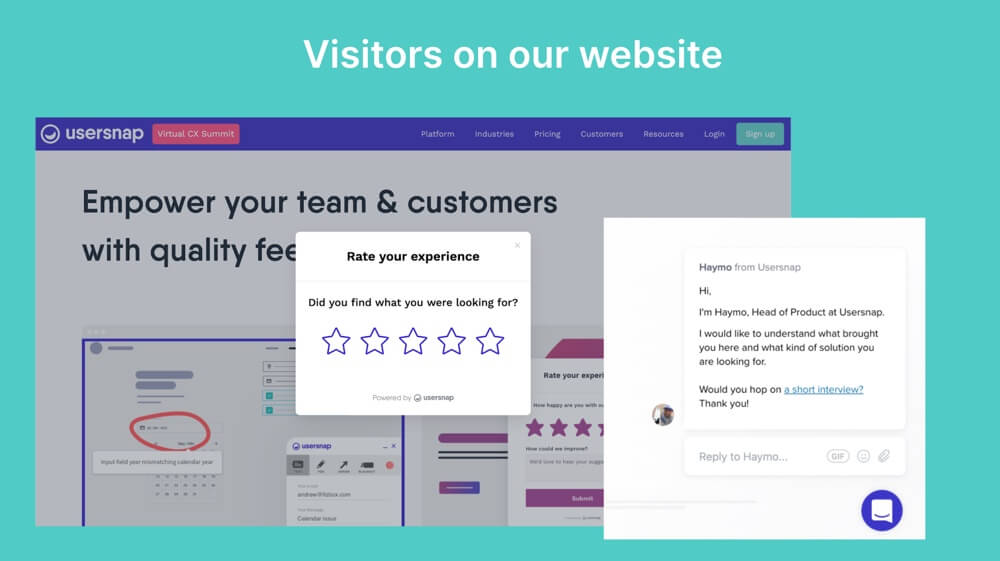
Additionally, we used simple surveys on the website. These were short open questions and they were either initiated by triggers after some time or on specific locations where the visitor was.
We got a lot of feedback from these requests on the website. Today, our product is doing this for us.
The data we got from the simple questions on the website gave us a good direction. We were not sure whether we could trust the data. After we had the analysis from the customer interviews we had the proof that micro feedback had a similar outcome but with a much broader base and significance.
We, for example, did validation on integration with Jira. We had some initial hypotheses about how integration with Jira could help us and we asked visitors on our landing pages about Jira. On the other hand, we did qualitative interviews with customers about Jira integration. Both methods brought similar results.
This strengthened our assumptions about building a customer feedback solution within Usersnap.
What we learned:
Asking simple questions on your website gave us insights on what visitors were specifically looking for.Combine them with personalized messages increased the response rateTo keep the respondents in the feedback loop, we asked them for their email. Doing that we follow-up with requests for more in-depth interviews based on their initial qualitative feedback message.
Addressing prospects who tried your product out
To learn more about the prospects who signed up for a free trial, we implemented personalized messages in our product.
How do they experience the value when they are on trial and Do they find what they are looking for
These were the central questions at that stage. We learned a lot about the AHA-moment and what they expected from collecting customer feedback.
When prospects tried out our product they got their first AHA-moment, when a new feedback item appeared in the dashboard. It showed them how this feedback solution will help them in the future to gather more insights into their customers.
Feedback was hard for us to collect. I don’t want to give you a false impression that you just have to ask and your customers will tell you everything you need to know.
In our experience, no user came to our product or website with the intention of giving us feedback. They had a job to be done and most of the time the reason they gave us feedback as if something was not working as they expected.
When we didn’t get enough feedback, we started experimenting with time-based triggers and sent a request for feedback when they were doing something specific. We showed a little bubble with the question popping up from the feedback button.
Triggering a feedback request at the right time was important to collect responses that were not only circling around problems and bugs of our product but what their challenges were.
We did not want to interfere when they were doing something, because it might distract them and they might feel disturbed. So we asked for feedback when a certain process was finished:
After leaving the signup page without signing upAfter inactivity for 2 minutes in the productAfter not installing our feedback widget within a certain timeAn invitation to share their experiences with integrations on the integrations page after integrating
Based on the click rates we had 30% more engagement with this method.
I don’t want to miss out on mentioning that it was super helpful that we have an amazing customer success team which was always helpful along the way. We could get a lot of feedback from conversations through our customer service chat.
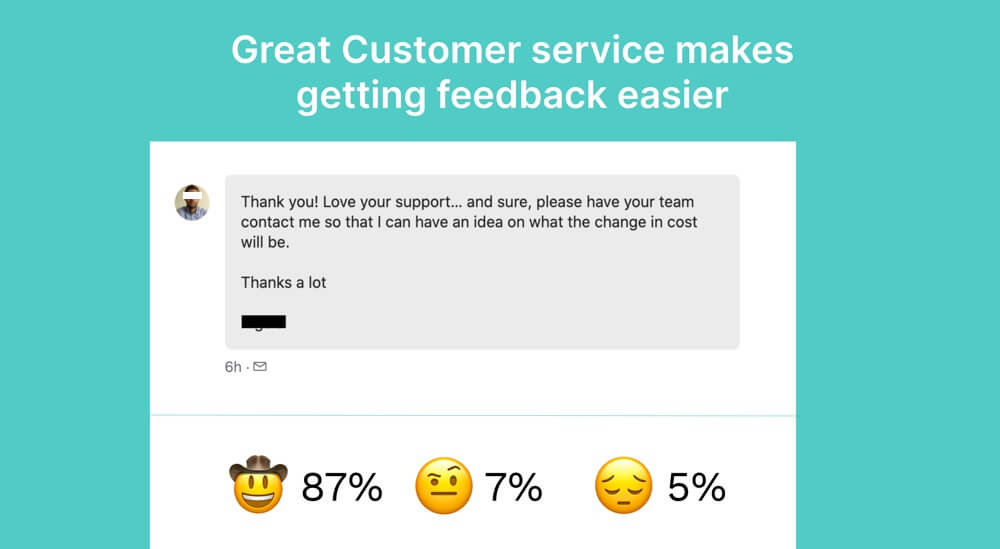
What we learned:
Feedback in trials helped us to figure out the AHA-moment of receiving feedback items in their dashboardAsking for feedback at the right time and at the right place can be essential to get quality feedbackThe Customer service team can be very helpful and giving insights from their conversations
Addressing them, after they bought
And then we are also talking to customers. In this stage, we talk to those who finally decided to jump on our product train.
As we know that 30% of our customers are coming directly to our website and via word-of-mouth, it was important for us to find out whether they would further spread the word and become ambassadors themselves.
To measure how likely they would recommend our solution to their friends and colleagues, we asked them to rate us based on NPS (Net Promoter Score). This one, measures how likely it is that your product gets recommended by the rating person.
And we asked for this feedback every 90 days. What we got was not only a trendline on their product loyalty represented by the NPS score but the open follow-up question gave us valuable qualitative insights.
We learned that we had quite a good NPS rating and could get an eye on changes in this metric.
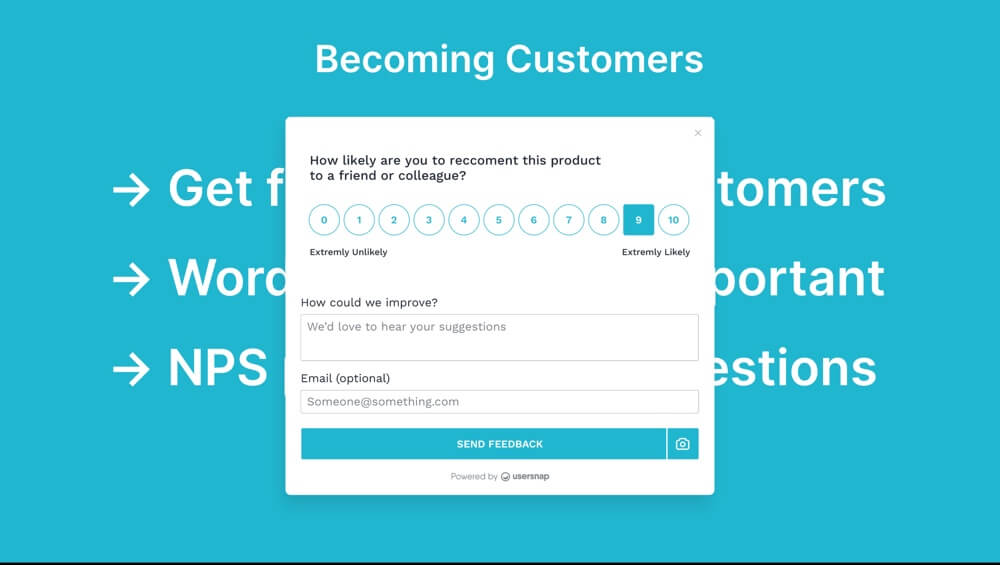
Additionally, we were reaching out via simple emails to segments of our customers who used the in customer feedback use cases and asking them for interviews.
We try to keep the emails as personal as possible and we started distributing this activity throughout all teams. For us to become customer-centric we had to involve everybody from sales, marketing, to product and development. Everyone needs to understand the customer and the best method to achieve this is by talking directly to the customer or at least hear it in their own words.
Before we built a feature, the person with a request for a feature had to show proof of the need and the pain of customers. We have a Confluence template for feature requests where you have to state the customer value and prove it with data and references.
I can remember, that in conversations with product managers, we heard repeatedly the pain of not having a central place for collecting these product ideas.
We also heard in the interviews that product requests are coming in via many channels and it’s unclear where to store them. Spreadsheets can be easily overwhelming and are lacking collaboration functionality.
The term “ideas portal” came up many times and after some more research, we decided to build a new use case in our product to make it easy to collect feature requests.
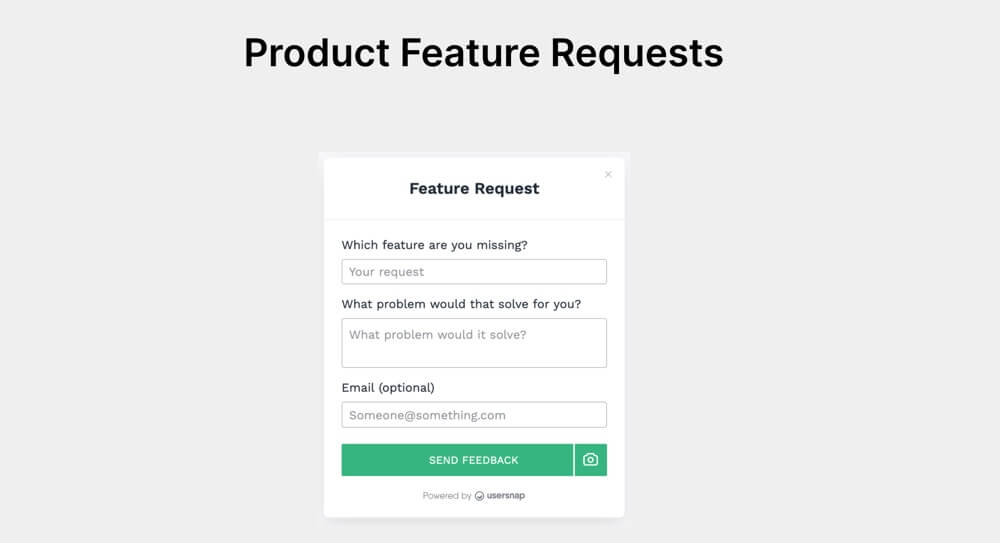
What we learned:
NPS with qualitative follow-up questions can be a good source of feedback and an indicator for your strength on word-of-mouthCustomer feedback brings insights into the needs and pains of our customer base and helps us on product feature decisions
Addressing them, when they left
One last stage should not be unmentioned because there is no other time of great honesty at the moment the customer decided to leave you behind.
Although it’s sad when they go, you can still get something out of it. We extended our cancelation form with a mandatory field for the reason why they want to cancel their subscription. Surprisingly most feedback was very helpful and only a few people complained about a mandatory field about the reason or filled it with nonsense.
When the feedback items from churning customers came in, we started using labels to cluster these feedback items.
Clusters were helping us to identify recurring patterns. From a six months analysis period, we had 81 times the reason that they left us because the project is over. 50 times the reason we were too expensive for them and 32 times the reason they didn’t get enough value for them. Digging “not enough value” reason we understood that it was often related to a project being finished so the value they had during the development process diminished once they were finished with the project.
What we learned
Many customers were leaving us not because they don’t like the product but because their project was overThe software companies we learned, in the beginning, had a longer lifetime because collecting user feedback in their products was not bound to a project.To make our product sticker we could invest in a customer feedback solution.
Start sharing
Since initially not everybody was involved in the process of collecting and processing the user feedback we thought it might be a good idea to share the key learnings with the team. We created a presentation and shared the learnings from the customer interviews and the qualitative feedback from our widget with the team in an all-hands meeting. Everybody was amazed.

Soon after this meeting we realized that they couldn’t recall the information about what we learned from the customers. The information was not sticky. We started thinking about how we can get the learnings to the team in a way that it becomes part of the daily work routine?
Our learning was that a single, specific statement or quote of a customer in their own words was way stickier, than if we told them what we learned. So we came up with a simple idea: “What if we share quotes and feedback items directly with the team (via Slack) and they can read the feedback themselves?”
With an automated integration to Slack we automatically shared all incoming feedback with the qualitative answers and the ratings with our team through Slack.

And I can remember the moment when we discussed in a heated conversation that we needed a new feature and one of the developers jumped into the discussion and recalled two feedback items he recently read in the channel which would support building this feature. This was the moment, when it became clear that we have to continue sharing feedback and even double down on it.
Becoming a customer-centric organization
Let me quickly recap what happened so far.
We implemented feedback on all touchpoints from potential over buying to churning customers. The same method to collect feedback did not work for all stages. At each stage a different method was more successful to collect feedback.
We brought feedback together in one system and used labels to get statistical data out of qualitative feedback. We integrated the feedback collection with other tools to break out from the data silo and introduce feedback in the daily routine of every employee.
Our current state of thinking is that software companies are the right target customers for us. We deliver more value across multiple stages and for a longer period of time.
By focusing on user feedback we will reduce our churn and increase our lifetime value per customer. As a result of this process our product has transitioned to a versatile user feedback platform for software companies.
We are solving multiple use cases for our customers and they stay longer with us.
Our achievements
Since we started our new feedback platform just 3 months ago we have doubled the monthly subscriptions.
We also increased the number of trial signups by 155% in the last 12 months.
The transformation of our organization
Prior to this customer-centric process our leadership decided about where the company should go and what the company should build. They understood the pains and needs of the customers and the market the best because they were having all the conversations and could transfer the information in a meaningful way to the team.
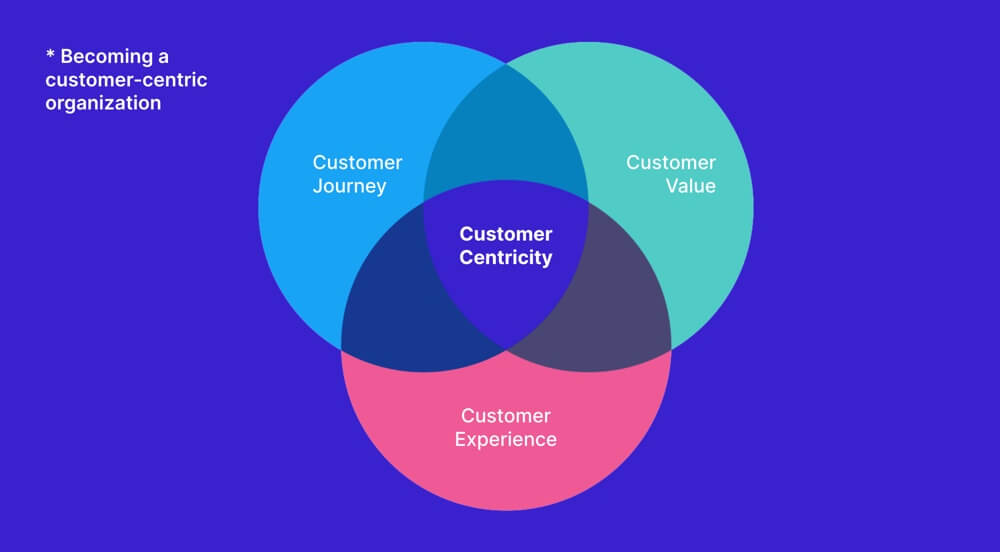
By involving in the collection of feedback and sharing all of it with the team we enabled the team to make decisions by themselves. This transformed our company into a more customer-centric organization.
The question “And how is this helping our customers?” is a constant companion now.
We changed the way we make decisions. We use data and customer quotes to make our decision.
This is how Usersnap became a more customer-centric company.
Key take-aways
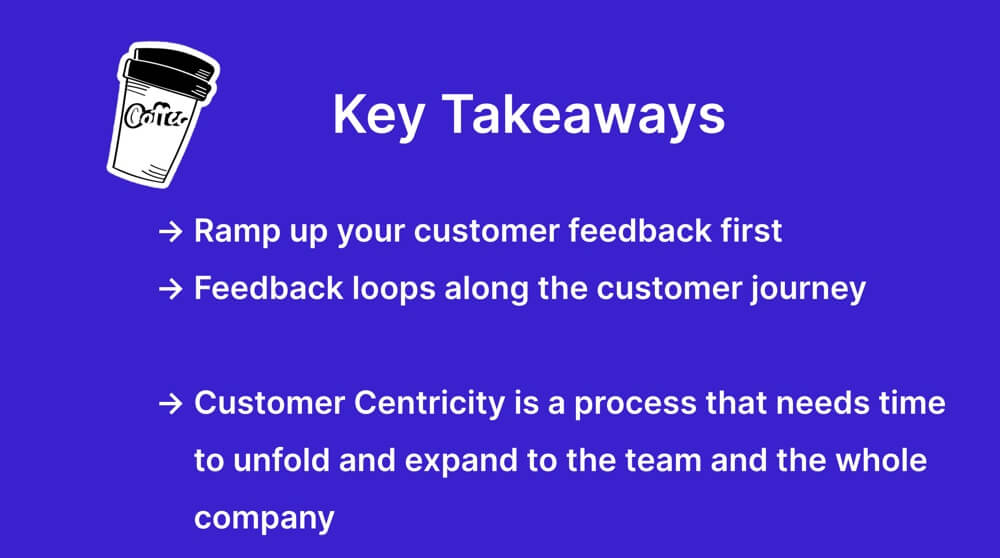
Becoming customer-centric means ramp up your customer feedback firstIntroduce feedback loops along the whole customer journeyShare customer feedback with your teamcustomer-centricity is a process that needs time to unfold and expand to every team and the company as a whole
Usersnap – the user feedback platform
Make feedback matterWe believe feedback-driven companies provide the best products to people. We put customers and their stories first: we listen, learn, improve, evaluate and we enable our customers to do the same.
Add user and customer feedback to your customer journey with Usersnap. Trying at least is for free.
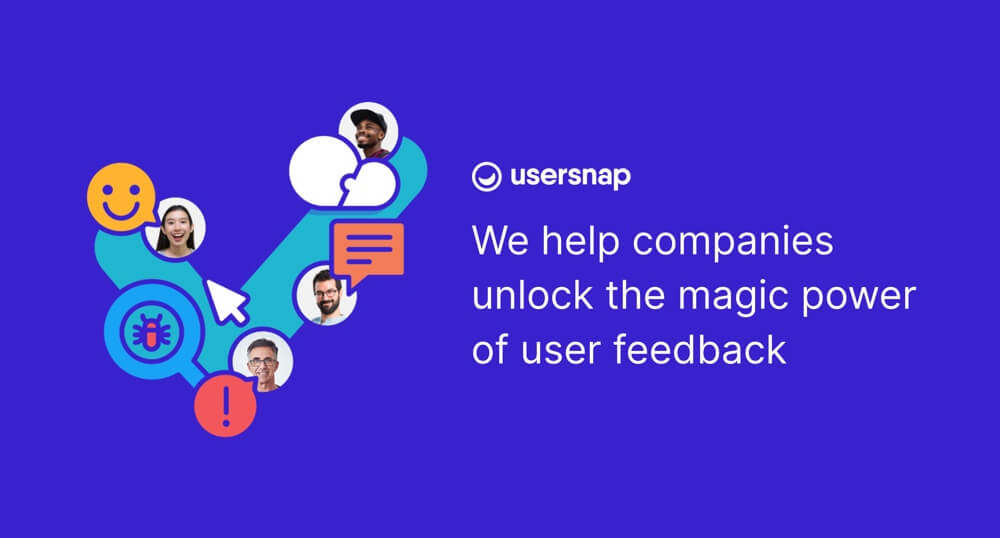
The post Customer-Centric Transformation with Power of Feedback – Talk @ Journey to CX Summit appeared first on Usersnap – Blog – Make feedback matter.
Read more: usersnap.com
